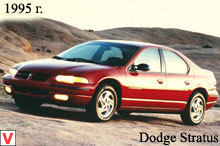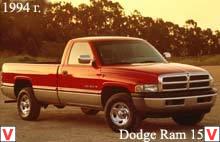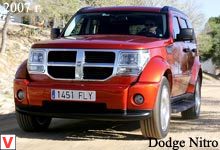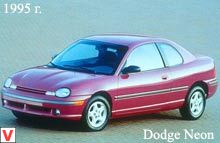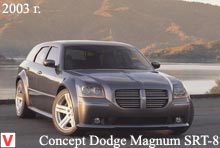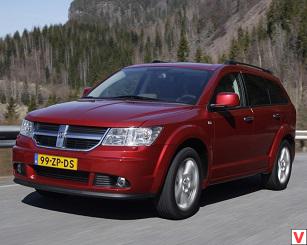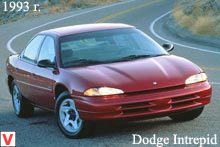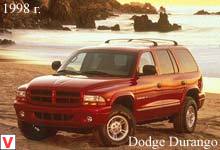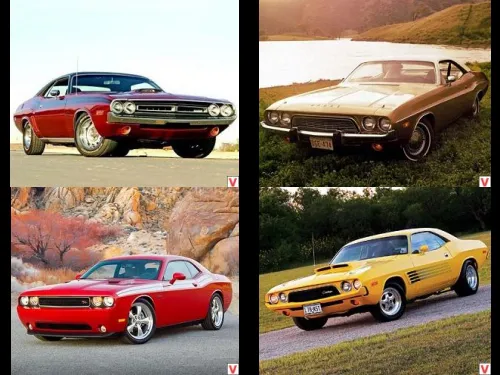
The forerunner of the appearance of the Challenger model in the Dodge lineup was the Silver Challenger - a two-door, four-seat coupe, released in 1959 in a limited edition. The Chrysler division of Chrysler Corporation returned to a wider use 11 years later, when it became urgent to create a competition for Ford with its Mustang and Chevrolet with its Camaro. As a result, after several years of development, the public was shown the Dodge Challenger of the 1970 model year, which was designed by the famous master Carl Cameron (Carl Cameron), the creator of the 1966 Charger model design. The body was made in the then fashionable form-factor “pony” - with an elongated hood and a short “stern”.
The car was produced in cabriolet and coupe bodies. The front part of the car was crowned with two pairs of round headlamps, a narrow, three-ribbed grille and a massive chrome bumper. Direction indicators in the then fashion were located in the front bumper, just under the headlights. The middle of the bonnet was made in a T-shape with air intakes (for modifications with engines of more than 5.9 liters). The car was built on the platform of E-body (wheelbase 2790 mm), which was also used on the oil-car Plymouth Barracuda.

By the way, many technical components (engines, suspension, chassis) Challenger borrowed from Barracuda. The car was equipped with a wide range of gasoline engines, six and eight-cylinder, in volume 3.2, 3.6, 5.2, 5.6, 6.2, 6.9 and 7.2 liters. They are aggregated with 3-speed automatic and mechanical transmissions. As an option for all versions offered 4-speed manual gearbox. Dodge Challenger I very successfully participated in the racing championships of the Trans American Sedan Championship. Especially for racing was built limited edition Dodge Challenger - Trans Am.
The road version was equipped with a 340 Six Pack engine with three Edelbrock two-chamber carburetors. Dodge claimed the power of the 340 Six Pack to 290 hp, but in fact the power reached 320 hp. The model was equipped with an automatic or manual four-speed gearbox, as well as power steering.
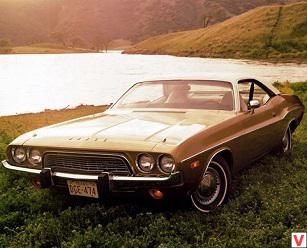
Front disc brakes are standard. T / A was one of the first mass-produced cars to use tires of various sizes: E60x15 in the front and G60x15 in the rear. Unfortunately, racing Challenger T / A was not competitive due to the fact that they had large heavy bodies to accommodate engines of this size, like the 426 Hemi, and 440 Magnum, and the road version suffered from severe understeer in fast corners. Only 2142 cars were made with the “T / A” index.
The spacious cabin is designed for 4 passengers, including the driver. A lot of complete sets were offered, which were replete with the most progressive equipment at that time (power windows, ceiling console with open door signs, no seat belts and fuel remaining in the tank). In 1972, the car received the first facelift, which touched the grille - its shape was then called a “sad smile” because of the downward angles of the grille. The car also received new taillights. Ceased to produce the Challenger in the back of a convertible. In 1973, designers once again put their hand to the grille, making it trapezoidal and wider.
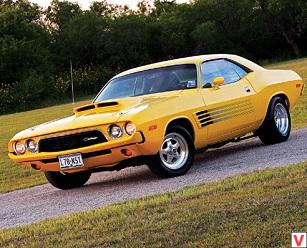
In addition to the changes in the front of the car, the rear optics changed - brake lights from the center of the "stern" migrated to its edges, their shape became rectangular - like with reversing lights and direction indicators. Rubber bumpers appeared on the bumpers (they were made to satisfy US safety regulations in crash tests). Also this year, the car received a new engine of 5.9 liters. But the model with a six-cylinder engine out of production. Dodge Challenger I after the premiere was very warmly received by the public. This is evidenced by the number of cars sold in 1970 - 76 935. Mostly the car was sold on the markets of the USA and Canada.
An exception was made for Switzerland and France. But despite the popularity, the coupe was criticized by the press, in connection with which sales of the model fell. In 1974, the production of a sports coupe was discontinued. About 165,500 copies of the model were sold.
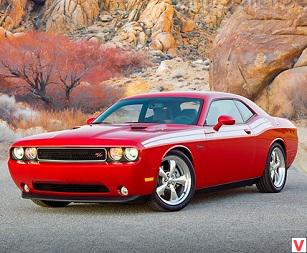
The revival of the legendary model Muscara occurred in 2008. The second generation debuted on February 6, 2008 at the same time at the Chicago (Chicago Auto Show) and Philadelphia (Philadelphia International Auto Show). The car is produced in the only body modification - a two-door, four-seater coupe. It is based on the Chrysler LC platform (wheelbase 2950 mm), and the body length is more than five meters. Exterior design decided to make as similar to that of the first generation.
The front part of the car with a powerful front bumper, a hood with a T-shaped elevation in the middle and aggressive twin block headlights focuses on the sports pedigree of this model. The car feed is also made in retro-style, with separate, rectangular-shaped brake lights, reversing lights and direction indicators. In the Challenger saloon, everything testifies to the sporting character of this car. And carbon-fiber trim interior, and sporty, clever steering wheel, and "racing design" of the dashboard with bluish backlighting. The release was carried out in two series.
One of them is Limited Edition 2008 SRT-8 with an automatic five-speed gearbox and a 6.1 liter Hemi engine producing 425 hp. It was produced from May to July 2008, 6400 pieces left the assembly line. In August 2008, they launched the second series, consisting of four models, including: Challenger SRT-8, Challenger SXT, Challenger SE and Challenger R / T. The Challenger R / T model was equipped with an eight-cylinder 5.7 liter Hemi combined with a 5-speed automatic transmission or a 6-speed manual transmission. On cars equipped with automatic transmission, the engine produces 372 hp. and 540 Nm of torque. With a 6-speed manual gearbox, the engine develops 376 hp. and 548 Nm of torque.
Versions SE and SXT equipped with six-cylinder 3.5 liter SOHC, whose power is 250 hp For the SE model, the Rallye package is offered, which includes a double strip on the hood and trunk, a trunk spoiler, 18-inch aluminum wheels and carbon inserts in the interior. The most powerful in the second series was the Dodge Challenger SRT-8 with a 6.8 liter Hemi engine with 470 horsepower. Starting in 2011, the Challenger began to equip with two new gasoline engines of 3.6 and 6.4 liters respectively. A 4-speed automatic transmission was discontinued. The Challenger of the second generation, of course, has noticeably changed its appearance.
There were modified spoilers, carbon inserts, wheels can be changed from 17 to 20 inches, they are now equipped with aluminum alloy wheels, heated seats, and the car itself became more aggressive and sportier, having slightly lost the charm of the 70s.

